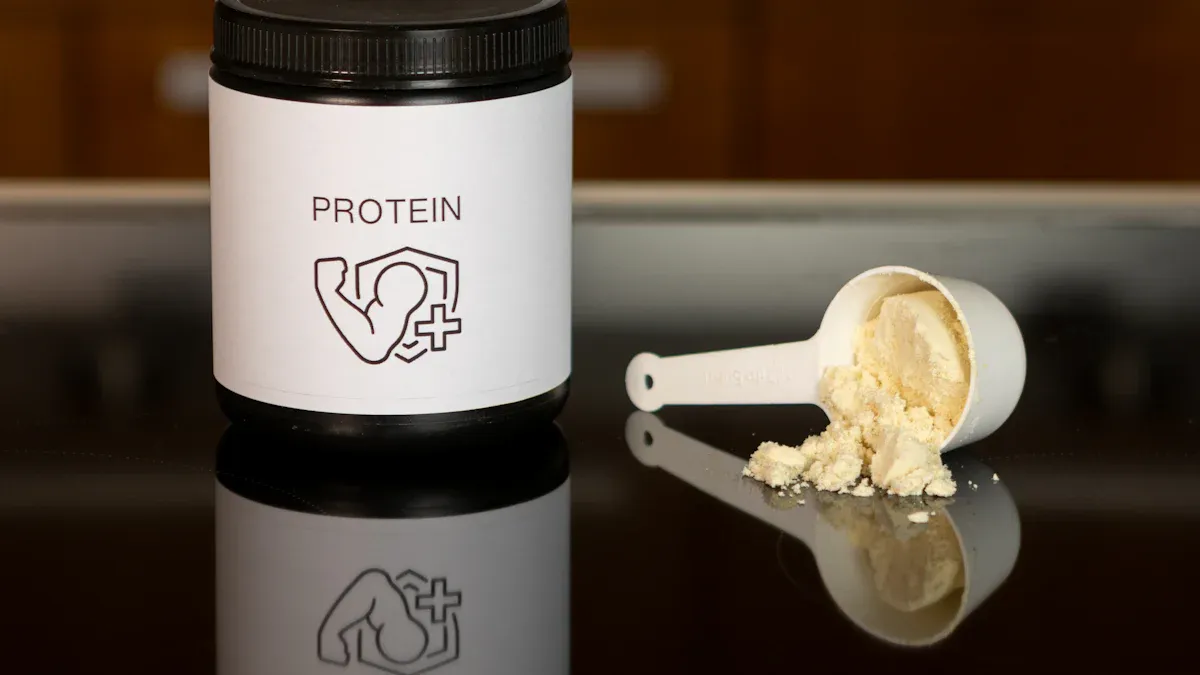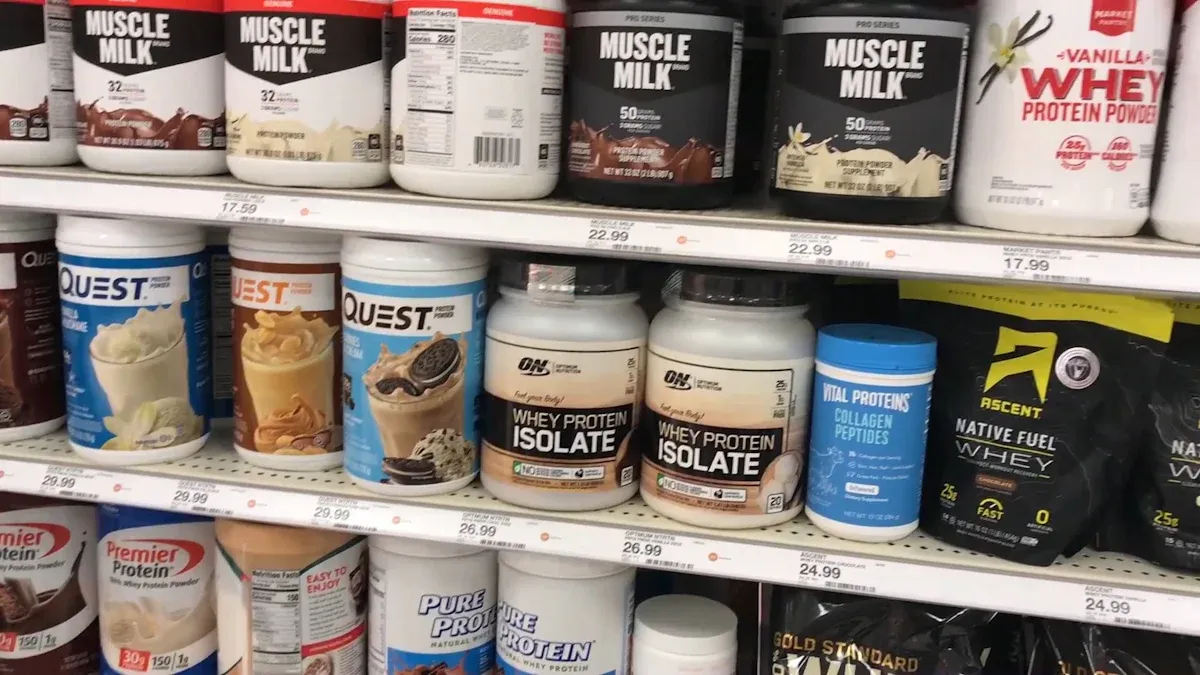You may wonder, is whey gluten free? Pure whey protein stays naturally gluten-free, so you can enjoy gluten-free whey protein without worry. Some whey protein powder products add gluten through flavorings or fillers. Cross-contamination can also happen in factories that process gluten. Always check labels for gluten-free certification to make sure you get gluten-free whey protein powders. You will find many gluten-free protein options for safe nutrition.
Tip: Look for trusted brands that offer gluten-free whey protein for peace of mind.
Key Takeaways
Pure whey protein powder does not have gluten. It comes from milk, not grains. Some whey protein powders have gluten. This can happen if flavors or fillers are added. Gluten can also get in during production. Always check the labels very carefully. Look for a gluten-free certification to be safe. Pick unflavored or certified gluten-free whey protein powders. This helps you avoid hidden gluten. Trusted brands with clear labels are safer. Certifications help people who need gluten-free whey protein.
Whey Protein and Gluten
What Is Whey Protein?
Whey protein comes from milk. When you make cheese, you separate the curds from the liquid. This liquid is called whey. You can turn whey into whey protein powder by using special filters. First, you get whey protein concentrate by removing some non-protein parts. Next, you use micro-filtration to make whey protein isolate, which has more protein and less fat or lactose. Some companies use enzymes to break down the protein into smaller pieces, creating whey protein hydrolysate. These steps help you get different types of protein powders for your protein shake.
Whey protein powder is popular because it mixes easily and gives you a high-quality source of protein. You can add it to your protein shake after exercise or use it to boost your daily nutrition. Animal-free whey protein uses microbes to make the same protein found in milk. This process does not use wheat, rye, or barley, so it stays gluten-free.
Note: Whey protein powder comes from milk, not grains. Milk does not have gluten, so pure whey protein is safe for people who need gluten-free whey protein.
Is Whey Gluten-Free?
You may ask, is whey gluten free? The answer is yes. Whey protein is naturally gluten-free because milk does not contain gluten. Gluten is a protein found in grains like wheat, rye, and barley. When you buy pure whey protein powder, you get a product that does not have gluten. All main forms—whey protein concentrate, whey protein isolate, and whey protein hydrolysate—are gluten-free. Scientific sources confirm that gluten-free whey protein is safe for people with celiac disease.
You should check labels before you buy protein powders. Some products add flavors or fillers that may contain gluten. If you want whey gluten-free options, look for products that say "gluten-free" on the label. Trusted brands make it easy for you to find safe protein shake choices.
Why Some Whey Protein Powders Contain Gluten
Additives and Fillers
Not every whey protein powder is gluten-free. Many flavored powders have extra things added. These extras help with taste, texture, or how long they last. Some of these added things can have gluten. For example, maltodextrin from wheat, malt syrup, or hydrolyzed wheat protein can add gluten. Cookies and cream flavors may use real cookie bits. These cookie pieces have gluten too.
Unflavored whey protein powders usually do not have these risky extras. If you want to avoid gluten, always read the ingredient list. Watch out for hidden gluten from barley, rye, or wheat-based things. Gluten-free labels help you pick safe choices. Flavored powders are more likely to have gluten than plain ones.
Tip: Pick simple, unflavored whey protein or those with a gluten-free label for the safest option.
Cross-Contamination Risks
Whey protein powder might not list gluten, but it can still get contaminated. This happens most in factories that make both gluten and gluten-free foods. Using the same machines and tools raises the risk. If cleaning is not good, gluten can stay behind. Gluten in the air can also land on whey protein during making.
Cross-contamination happens when gluten foods and gluten-free whey protein are made in the same place.
Using the same tools makes the risk higher.
Not cleaning well between batches leaves gluten behind.
Gluten in the air can fall on whey protein during processing.
If you cannot eat gluten, even a little bit can make you sick. You might get stomach pain, bloating, or diarrhea. Some people also have trouble digesting whey protein, which can make things worse. Good companies use strong cleaning and testing to keep their powders safe. They often use the R5 ELISA test to find tiny amounts of gluten.
Note: Always look for gluten-free labels and clear ingredient lists to lower your risk of getting gluten.
How to Find Gluten-Free Whey Protein Powders
Reading Labels
When you shop, read labels very carefully. First, look for a "gluten-free" label on the front. In the U.S., this label means the product has very little gluten. Some brands use even stricter rules. For example, GFCO allows even less gluten in their products.
Check the ingredient list for wheat, barley, or rye. These grains always have gluten. Watch out for hidden gluten like malt syrup or hydrolyzed wheat protein. Modified food starch can also have gluten. Some flavors, like cookies and cream, may have cookie pieces with gluten. If you see "Contains: Wheat" near the ingredients, do not buy it.
Tip: Always check allergen statements and look for gluten or wheat.
See if the brand explains how they keep gluten out. Some companies use special factories and test their powders. This helps keep gluten away from your whey protein.
Here are steps to follow when you read labels:
Find a "gluten-free" seal on the package.
Check allergen statements for wheat or gluten.
Read the ingredient list for hidden gluten.
Learn about the brand’s factory rules.
Ask the company questions if you are not sure.
Gluten-Free Certifications
Gluten-free certifications help you feel safe when you pick whey protein powders. These seals show the product meets strict rules for gluten. NSF and GFCO are two trusted groups. Both are known around the world and test products often.
Certification Organization | Recognized Internationally | Gluten Threshold Requirement | Key Requirements |
NSF Gluten-Free Certification | Yes | 20 ppm or less | Needs a gluten-free plan, checks at the factory, tests products, audits, and checks where ingredients come from. |
Gluten-Free Certification Organization (GFCO) | Yes | 10 ppm or less | All ingredients must be approved and have very little gluten; no barley; regular tests; yearly checks; follow allergen rules. |
If you see these seals, the whey protein passed tough tests. Certified gluten-free powders are safer for people who cannot eat gluten. These seals also mean the company works hard to keep gluten out.
Note: Even with a seal, always read the label and ingredients. Mistakes can happen, so checking keeps you safe.
Ingredients to Avoid
Some ingredients can hide gluten in protein powders. You need to know which ones to avoid. Whey protein comes from milk and does not have gluten. Problems start when companies add flavors or other extras.
Common ingredients with gluten to avoid are:
Wheat flour, wheat starch, or modified wheat starch
Malt syrup or malt extract from barley
Hydrolyzed wheat protein
Brewer’s yeast
Graham flour, spelt, bulgur
Barley or rye-based ingredients
Oats (unless marked gluten-free)
Some things like natural flavors or modified food starch may have gluten. Only trust them if the product says "gluten-free" on the label.
Watch out for cross-contamination too. If the powder is made in a place that uses wheat, barley, or rye, the risk is higher. Certified gluten-free powders are safer because they use strong rules and tests.
Callout: If you do not know about an ingredient, ask the company or talk to your doctor. You can also use apps or online tools to check ingredients.
Picking gluten-free whey protein powders helps you stay safe. Look for clear labels, trusted seals, and simple ingredients. This way, you can find gluten-free products for your protein needs.
Trusted Gluten-Free Whey Protein Brands
JAYHOO Whey Protein Powder
If you want a safe gluten-free whey protein, try JAYHOO. This brand checks every batch with strong tests. They make sure it stays gluten-free. JAYHOO shows all the ingredients on the label. You always know what is inside. Many people with gluten problems pick JAYHOO. They trust it for shakes and recipes. JAYHOO cares about safety and good quality.
Tip: Always look for a gluten-free label on JAYHOO before buying.
Other Recommended Brands
There are many gluten-free whey protein brands to pick from. Some brands use outside labs to check for gluten. These brands get special certificates for being gluten-free. This means they follow strict rules. Here are some top brands you can trust:
Brand Name | Certification(s) | Certification Source/Method | Additional Notes |
Just Ingredients | Certified Gluten-Free | Third-party testing for gluten absence | Also tested for heavy metals and microbiological contamination |
Simply Tera’s Organic | Certified Gluten-Free, USDA Organic, Non-GMO Project Verified | Certified gluten-free by major certifiers | Also kosher certified and packaged in recycled plastic |
Certified gluten-free whey protein powders can cost more money. The higher price is because of extra tests and checks. For example, Sports Research Whey Protein Isolate and Momentous Essential Grass-Fed Whey both have certificates. They cost between $1.27 and $2.93 for each serving. Nutricost Whey Protein Concentrate is not certified. It costs less, about $0.87 for each serving.
Product Name | Certification Status | Price per Serving (USD) | Notes |
Sports Research Whey Protein Isolate | Third-party tested & certified | $1.27 - $1.46 | Gluten-free, muscle-building, 25g protein per serving |
Momentous Essential Grass-Fed Whey | Third-party tested & certified | $2.93 | Premium, grass-fed, NSF-certified, no artificial sweeteners |
Nutricost Whey Protein Concentrate | Gluten-free, not explicitly certified | $0.87 | Budget-friendly, third-party tested, GMP-compliant |
Note: Picking certified gluten-free brands helps you stay safe. You might pay more, but you do not have to worry about gluten.
Always check for clear labels and trusted seals. This helps you enjoy your whey protein without fear of gluten.
Pure whey does not have gluten. Some powders can get gluten from added ingredients or from being made near gluten foods. Always read the label before you buy. Look for a gluten-free seal on the package. Check the ingredient list for hidden gluten. Certified gluten-free powders are safer because they follow strict rules. Trusted brands make it easier to stay safe. There are many good gluten-free choices. You can find what you need and feel sure about your food.
FAQ
Can you use whey protein if you have celiac disease?
Yes, you can use pure whey protein if you have celiac disease. Always check for a gluten-free label. Some powders have gluten from additives or cross-contamination. Pick certified gluten-free brands for safety.
How do you know if a whey protein powder is gluten-free?
Look for a "gluten-free" label on the package. Read the ingredient list for wheat, barley, or rye. Trusted brands show certifications. If you feel unsure, contact the company for more details.
Are flavored whey protein powders safe for gluten-free diets?
Some flavored whey protein powders have gluten. Flavors like cookies and cream may use cookie pieces with gluten. Always read the label and check for gluten-free certification before you buy flavored options.
What should you do if you react to a "gluten-free" whey protein powder?
Stop using the product right away.
Save the package and contact your doctor.
Report the reaction to the company and the FDA.
Choose another certified gluten-free brand for your next purchase.

































